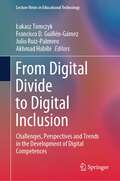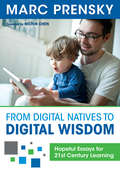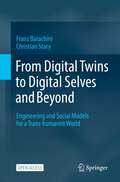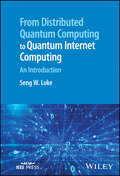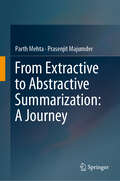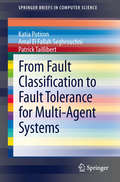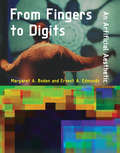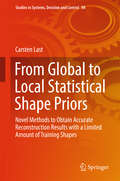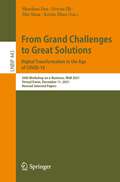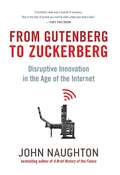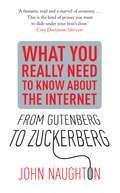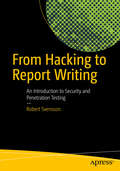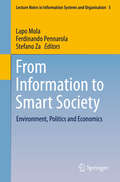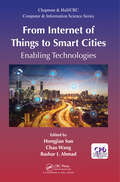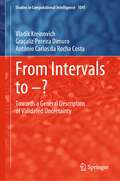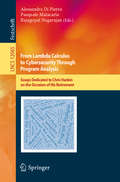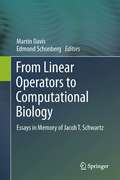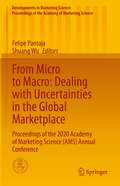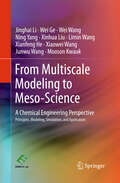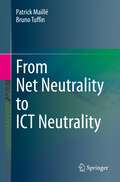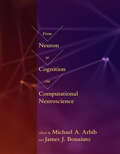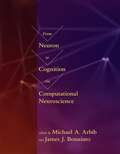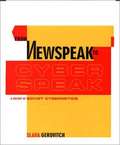- Table View
- List View
From Digital Divide to Digital Inclusion: Challenges, Perspectives and Trends in the Development of Digital Competences (Lecture Notes in Educational Technology)
by Łukasz Tomczyk Francisco D. Guillén-Gámez Julio Ruiz-Palmero Akhmad HabibiThis book offers an expert perspective on two key phenomena in the development of the information society, namely digital inclusion and digital exclusion. Despite the intensive digitalization of various areas in human activity, the lack of proper information and communications technology (ICT) literacy, the lack of access to high-speed Internet, and the still unsatisfactory level of e-services are a reality in many regions and countries. This edited book presents a unique overview of research related to the dynamics of digital exclusion and the development of digital competences, as well as an analysis of the most effective educational solutions to foster the digital inclusion of disadvantaged groups. This book is particularly useful for educators dealing with the topic of digital exclusion and inclusion and who are looking for knowledge on enhancing digital competences in disadvantaged groups. It is also helpful for social policy makers involved in designing solutions to minimize various forms of digital exclusion. Finally, this book serves as a reference for academics and students from the disciplines of pedagogy, social policy, new media psychology, media sociology, and cultural anthropology.
From Digital Natives to Digital Wisdom: Hopeful Essays for 21st Century Learning
by Marc R. PrenskyAn expert perspective on 21st century education What can you learn on a cell phone? Almost anything! How does that concept fit with our traditional system of education? It doesn’t. Best-selling author and futurist Marc Prensky’s book of essays challenges educators to “reboot” and make the changes necessary to prepare students for 21st century careers and living. His “bottom-up” vision includes students’ ideas about what they need from teachers, schools, and education. Also featured are easy-to-do, high-impact classroom strategies that help students acquire “digital wisdom.” This thought-provoking text is organized into two sections that address: Rethinking education (including what and how we teach and measuring learning) 21st century learning and technology in the classroom (including games, YouTube, and more)
From Digital Twins to Digital Selves and Beyond: Engineering and Social Models for a Trans-humanist World
by Franz Barachini Christian StaryThis open access book aims at deepening the understanding of the relation between cyber-physical systems (CPSs) as socio-technical systems and their digital representations with intertwined artificial intelligence (AI). The authors describe why it is crucial for digital selves to be able to develop emotional behavior and why a humanity-inspired AI is necessary so that humans and humanoids can coexist. The introductory chapter describes major milestones in computer science which form the basis for the implementation of digital twins and digital selves. The subsequent Part I then lays the foundation to develop a socio-technical understanding of the nature of digital twins as representations and trans-human development objects. Following the conceptual understanding of digital twins and how they could be engineered according to cognitive and organizational structures, Part II forms the groundwork for understanding social behavior and its modeling. It discusses various perception-based socio-emotional approaches before sketching behavior-relevant models and their simulation capabilities. In particular, it is shown how emotions can substantially influence the collective behavior of artificial actors. Part III eventually presents a symbiosis showing under which preconditions digital selves might construct and produce digital twins as integrated design elements in trans-human ecosystems. The chapters in this part are dedicated to opportunities and modes of co-creating reflective socio-trans-human systems based on digital twin models, exploring mutual control and continuous development. The final epilog is congenitally speculative in its nature by presenting thoughts on future developments of artificial life in computational substrates. The book is written for researchers and professionals in areas like cyber-physical systems, robotics, social simulation or systems engineering, interested to take a speculative look into the future of digital twins and autonomous agents. It also touches upon philosophical aspects of digital twins, digital selves and humanoids.
From Distributed Quantum Computing to Quantum Internet Computing: An Introduction
by Seng W. LokeFrom Distributed Quantum Computing to Quantum Internet Computing Understand the future of the internet with this accessible guide Quantum computing, which draws upon the principles of quantum mechanics to perform computing functions unrestricted by the binary language of ordinary computing, has developed with extraordinary speed in recent years. Progress in quantum computing and its related technological subfields, including quantum internet, has been rapid enough to suggest that we are living in a “new Quantum Age.” To understand the future of the internet, it’s now essential to understand the present and future of quantum computing and quantum internet computing. This book provides a groundbreaking overview of this field of technology and its latest developments. It provides readers with a working knowledge of the key topics required to connect quantum computing to the future of distributed computing and the internet, including important issues like quantum protocols, distributed quantum computations, fundamental computations in the quantum internet architecture, and more. The result is an accessible and essential reference for any reader looking to better understand quantum technologies. From Distributed Quantum Computing to Quantum Internet Computing readers will also find: Detailed discussion of topics including qubit states, entanglement, quantum gates, and more. Mathematical background for underlying key concepts. Worked out examples that aim to initiate readers into the emerging area of quantum internet computing. This book is ideal for researchers and graduate students in quantum computing, quantum internet, quantum communications, and related fields, as well as Computer Scientists and Information Technology students and researchers who want an introductory overview to quantum internet computing.
From Extractive to Abstractive Summarization: A Journey
by Parth Mehta Prasenjit MajumderThis book describes recent advances in text summarization, identifies remaining gaps and challenges, and proposes ways to overcome them. It begins with one of the most frequently discussed topics in text summarization – ‘sentence extraction’ –, examines the effectiveness of current techniques in domain-specific text summarization, and proposes several improvements. In turn, the book describes the application of summarization in the legal and scientific domains, describing two new corpora that consist of more than 100 thousand court judgments and more than 20 thousand scientific articles, with the corresponding manually written summaries. The availability of these large-scale corpora opens up the possibility of using the now popular data-driven approaches based on deep learning. The book then highlights the effectiveness of neural sentence extraction approaches, which perform just as well as rule-based approaches, but without the need for any manual annotation. As a next step, multiple techniques for creating ensembles of sentence extractors – which deliver better and more robust summaries – are proposed. In closing, the book presents a neural network-based model for sentence compression. Overall the book takes readers on a journey that begins with simple sentence extraction and ends in abstractive summarization, while also covering key topics like ensemble techniques and domain-specific summarization, which have not been explored in detail prior to this.
From Fault Classification to Fault Tolerance for Multi-Agent Systems
by Amal El Fallah Seghrouchni Patrick Taillibert Katia PotironFaults are a concern for Multi-Agent Systems (MAS) designers, especially if the MAS are built for industrial or military use because there must be some guarantee of dependability. Some fault classification exists for classical systems, and is used to define faults. When dependability is at stake, such fault classification may be used from the beginning of the system's conception to define fault classes and specify which types of faults are expected. Thus, one may want to use fault classification for MAS; however, From Fault Classification to Fault Tolerance for Multi-Agent Systems argues that working with autonomous and proactive agents implies a special analysis of the faults potentially occurring in the system. Moreover, the field of Fault Tolerance (FT) provides numerous methods adapted to handle different kinds of faults. Some handling methods have been studied within the MAS domain, adapting to their specificities and capabilities but increasing the large amount of FT methods. Therefore, unless being an expert in fault tolerance, it is difficult to choose, evaluate or compare fault tolerance methods, preventing a lot of developed applications from not only to being more pleasant to use but, more importantly, from at least being tolerant to common faults. From Fault Classification to Fault Tolerance for Multi-Agent Systems shows that specification phase guidelines and fault handler studies can be derived from the fault classification extension made for MAS. From this perspective, fault classification can become a unifying concept between fault tolerance methods in MAS.
From Fingers to Digits: An Artificial Aesthetic (Leonardo)
by Margaret A. Boden Ernest A. EdmondsEssays on computer art and its relation to more traditional art, by a pioneering practitioner and a philosopher of artificial intelligence.In From Fingers to Digits, a practicing artist and a philosopher examine computer art and how it has been both accepted and rejected by the mainstream art world. In a series of essays, Margaret Boden, a philosopher and expert in artificial intelligence, and Ernest Edmonds, a pioneering and internationally recognized computer artist, grapple with key questions about the aesthetics of computer art. Other modern technologies—photography and film—have been accepted by critics as ways of doing art. Does the use of computers compromise computer art's aesthetic credentials in ways that the use of cameras does not? Is writing a computer program equivalent to painting with a brush?Essays by Boden identify types of computer art, describe the study of creativity in AI, and explore links between computer art and traditional views in philosophical aesthetics. Essays by Edmonds offer a practitioner's perspective, considering, among other things, how the experience of creating computer art compares to that of traditional art making. Finally, the book presents interviews in which contemporary computer artists offer a wide range of comments on the issues raised in Boden's and Edmonds's essays.
From Global to Local Statistical Shape Priors
by Carsten LastThis book proposes a new approach to handle the problem of limited training data. Common approaches to cope with this problem are to model the shape variability independently across predefined segments or to allow artificial shape variations that cannot be explained through the training data, both of which have their drawbacks. The approach presented uses a local shape prior in each element of the underlying data domain and couples all local shape priors via smoothness constraints. The book provides a sound mathematical foundation in order to embed this new shape prior formulation into the well-known variational image segmentation framework. The new segmentation approach so obtained allows accurate reconstruction of even complex object classes with only a few training shapes at hand.
From Grand Challenges to Great Solutions: 20th Workshop on e-Business, WeB 2021, Virtual Event, December 11, 2021, Revised Selected Papers (Lecture Notes in Business Information Processing #443)
by Shaokun Fan Noyan Ilk Zhe Shan Kexin ZhaoThis book constitutes revised selected papers from the 20th Workshop on e-Business, WeB 2021, which took place virtually on December 11, 2021.The purpose of WeB is to provide a forum for researchers and practitioners to discuss findings, novel ideas, and lessons learned to address major challenges and map out the future directions for e-Business. The WeB 2021 theme was “From Grand Challenges to Great Solutions: Digital Transformation in the Age of COVID-19.” The 8 papers included in this volume were carefully reviewed and selected from a total of 24 submissions. The contributions are organized in topical sections as follows: digital innovation and transformation, and e-commerce and social media.
From Gutenberg to Zuckerberg: What You Really Need to Know About the Internet
by John NaughtonJohn Naughton is the Observer's 'Networker' columnist, a prominent blogger, and Vice-President of Wolfson College, Cambridge. The Times has said that his writings, "[it] draws on more than two decades of study to explain how the internet works and the challenges and opportunities it will offer to future generations," and Cory Doctrow raved that "this is the kind of primer you want to slide under your boss's door." In From Gutenberg to Zuckerberg, Naughton explores the living history of one of the most radically transformational technologies of all time. From Gutenberg to Zuckerberg is a clear-eyed history of one of the most central, and yet most taken-for-granted, features of modern life: the internet. Once a technological novelty and now the very plumbing of the Information Age, the internet is something we have learned to take largely for granted. So, how exactly has our society become so dependent upon a utility it barely understands? And what does it say about us that this is so? While explaining in highly engaging language the way the internet works and how it got to be the way it is, technologist John Naughton has distilled the noisy chatter surrounding the technology's relentless evolution into nine essential areas of understanding. In doing so, he affords readers deeper insight into the information economy and supplies the requisite knowledge to make better use of the technologies and networks around us, highlighting some of their fascinating and far-reaching implications along the way.From the Hardcover edition.
From Gutenberg to Zuckerberg: What You Really Need to Know About the Internet
by John NaughtonWe've gone from regarding the Net as something exotic to something that we take for granted, like mains electricity or running water. Yet most people have no idea how the network functions, nor any conception of its architecture; and few can explain why it has been - and continues to be - so uniquely disruptive in social, economic and cultural contexts. John Naughton has been thinking, arguing, lecturing and writing about the Net for over two and a half decades, and in FROM GUTENBERG TO ZUCKERBERG he distills the noisy chatter surrounding the internet's relentless evolution into nine clear-sighted and accessible areas of understanding.FROM GUTENBERG TO ZUCKERBERG gives you the requisite knowledge to make better use of the technologies and networks around and raises important questions, as exciting as they are unsettling, about the future of the Net and the impact it will have on our lives.
From Gutenberg to Zuckerberg: What You Really Need to Know About the Internet
by John NaughtonWe've gone from regarding the Net as something exotic to something that we take for granted, like mains electricity or running water. Yet most people have no idea how the network functions, nor any conception of its architecture; and few can explain why it has been - and continues to be - so uniquely disruptive in social, economic and cultural contexts. John Naughton has been thinking, arguing, lecturing and writing about the Net for over two and a half decades, and in FROM GUTENBERG TO ZUCKERBERG he distills the noisy chatter surrounding the internet's relentless evolution into nine clear-sighted and accessible areas of understanding.FROM GUTENBERG TO ZUCKERBERG gives you the requisite knowledge to make better use of the technologies and networks around and raises important questions, as exciting as they are unsettling, about the future of the Net and the impact it will have on our lives.
From Hacking to Report Writing
by Robert SvenssonLearn everything you need to know to become a professional security and penetration tester. It simplifies hands-on security and penetration testing by breaking down each step of the process so that finding vulnerabilities and misconfigurations becomes easy. The book explains how to methodically locate, exploit, and professionally report security weaknesses using techniques such as SQL-injection, denial-of-service attacks, and password hacking. Although From Hacking to Report Writing will give you the technical know-how needed to carry out advanced security tests, it also offers insight into crafting professional looking reports describing your work and how your customers can benefit from it. The book will give you the tools you need to clearly communicate the benefits of high-quality security and penetration testing to IT-management, executives and other stakeholders. Embedded in the book are a number of on-the-job stories that will give you a good understanding of how you can apply what you have learned to real-world situations. We live in a time where computer security is more important than ever. Staying one step ahead of hackers has never been a bigger challenge. From Hacking to Report Writing clarifies how you can sleep better at night knowing that your network has been thoroughly tested. What you'll learn Clearly understand why security and penetration testing is important Find vulnerabilities in any system using the same techniques as hackers do Write professional looking reports Know which security and penetration testing method to apply for any given situation Successfully hold together a security and penetration test project Who This Book Is For Aspiring security and penetration testers, security consultants, security and penetration testers, IT managers, and security researchers.
From Information to Smart Society
by Lapo Mola Ferdinando Pennarola Stefano ZaThis book presents a collection of research papers focusing on issues emerging from the interaction of information technologies and organizational systems. In particular, the individual contributions examine digital platforms and artifacts currently adopted in both the business world and society at large (people, communities, firms, governments, etc. ). The topics covered include: virtual organizations, virtual communities, smart societies, smart cities, ecological sustainability, e-healthcare, e-government, and interactive policy-making (IPM). The book offers a multidisciplinary perspective on a variety of information systems topics. It is also particularly relevant to information systems practitioners such as IS managers, business managers and policy makers. The content is based on a selection of the best papers (original double-blind peer-reviewed contributions) presented at the annual conference of the Italian chapter of AIS, which was held in Milan, Italy in December 2013.
From Internet of Things to Smart Cities: Enabling Technologies (Chapman & Hall/CRC Computer and Information Science Series)
by Bashar Ahmad Hongjian Sun Chao WangFrom Internet of Things to Smart Cities: Enabling Technologies explores the information and communication technologies (ICT) needed to enable real-time responses to current environmental, technological, societal, and economic challenges. ICT technologies can be utilized to help with reducing carbon emissions, improving resource utilization efficiency, promoting active engagement of citizens, and more. This book aims to introduce the latest ICT technologies and to promote international collaborations across the scientific community, and eventually, the general public. It consists of three tightly coupled parts. The first part explores the involvement of enabling technologies from basic machine-to-machine communications to Internet of Things technologies. The second part of the book focuses on state of the art data analytics and security techniques, and the last part of the book discusses the design of human-machine interfaces, including smart home and cities. Features Provides an extended literature review of relevant technologies, in addition to detailed comparison diagrams, making new readers be easier to grasp fundamental and wide knowledge Contains the most recent research results in the field of communications, signal processing and computing sciences for facilitating smart homes, buildings, and cities Includes future research directions in Internet of Things, smart homes, smart buildings, smart grid, and smart cities Presents real examples of applying these enabling technologies to smart homes, transportation systems and cities With contributions from leading experts, the book follows an easy structure that not only presents timely research topics in-depth, but also integrates them into real world applications to help readers to better understand them.
From Intervals to –?: Towards a General Description of Validated Uncertainty (Studies in Computational Intelligence #1041)
by Vladik Kreinovich Graçaliz Pereira Dimuro Antônio Carlos da Rocha CostaThis book is about methodological aspects of uncertainty propagation in data processing. Uncertainty propagation is an important problem: while computer algorithms efficiently process data related to many aspects of their lives, most of these algorithms implicitly assume that the numbers they process are exact. In reality, these numbers come from measurements, and measurements are never 100% exact. Because of this, it makes no sense to translate 61 kg into pounds and get the result—as computers do—with 13 digit accuracy. In many cases—e.g., in celestial mechanics—the state of a system can be described by a few numbers: the values of the corresponding physical quantities. In such cases, for each of these quantities, we know (at least) the upper bound on the measurement error. This bound is either provided by the manufacturer of the measuring instrument—or is estimated by the user who calibrates this instrument. However, in many other cases, the description of the system is more complex than a few numbers: we need a function to describe a physical field (e.g., electromagnetic field); we need a vector in Hilbert space to describe a quantum state; we need a pseudo-Riemannian space to describe the physical space-time, etc. To describe and process uncertainty in all such cases, this book proposes a general methodology—a methodology that includes intervals as a particular case. The book is recommended to students and researchers interested in challenging aspects of uncertainty analysis and to practitioners who need to handle uncertainty in such unusual situations.
From Lambda Calculus to Cybersecurity Through Program Analysis: Essays Dedicated to Chris Hankin on the Occasion of His Retirement (Lecture Notes in Computer Science #12065)
by Alessandra Di Pierro Pasquale Malacaria Rajagopal NagarajanThis Festschrift is in honor of Chris Hankin, Professor at the Imperial College in London, UK, on the Occasion of His 65th Birthday.Chris Hankin is a Fellow of the Institute for Security Science and Technology and a Professor of Computing Science.His research is in cyber security, data analytics and semantics-based program analysis. He leads multidisciplinary projects focused on developing advanced visual analytics and providing better decision support to defend against cyber attacks. This Festschrift is a collection of scientific contributions related to the topics that have marked the research career of Professor Chris Hankin. The contributions have been written to honour Chris' career and on the occasion of his retirement.
From Linear Operators to Computational Biology
by Martin Davis Edmond SchonbergIn his rich and varied career as a mathematician, computer scientist, and educator, Jacob T. Schwartz wrote seminal works in analysis, mathematical economics, programming languages, algorithmics, and computational geometry. In this volume of essays, his friends, students, and collaborators at the Courant Institute of Mathematical Sciences present recent results in some of the fields that Schwartz explored: quantum theory, the theory and practice of programming, program correctness and decision procedures, dextrous manipulation in Robotics, motion planning, and genomics. In addition to presenting recent results in these fields, these essays illuminate the astonishingly productive trajectory of a brilliant and original scientist and thinker.
From Mainframes to Smartphones
by Daniel D. Garcia-Swartz Martin Campbell-KellyThis compact history traces the computer industry from its origins in 1950s mainframes, through the establishment of standards beginning in 1965 and the introduction of personal computing in the 1980s. It concludes with the Internet’s explosive growth since 1995. <P><P>Across these four periods, Martin Campbell-Kelly and Daniel Garcia-Swartz describe the steady trend toward miniaturization and explain its consequences for the bundles of interacting components that make up a computer system. With miniaturization, the price of computation fell and entry into the industry became less costly. Companies supplying different components learned to cooperate even as they competed with other businesses for market share. Simultaneously with miniaturization―and equally consequential―the core of the computer industry shifted from hardware to software and services. Companies that failed to adapt to this trend were left behind.
From Micro to Macro: Proceedings of the 2019 Academy of Marketing Science (AMS) Annual Conference (Developments in Marketing Science: Proceedings of the Academy of Marketing Science)
by Shuang Wu Felipe PantojaThe focus of the volume is on dealing with uncertainties and challenges within the global marketplace brought by digital technology companies that are leveraging artificial intelligence, machine learning, cloud computing, robotic automation, augmented reality, and other recent advancements. Additionally, these companies operate in the sharing economy and offer collaborative consumption opportunities. Featuring contributions presented at the 2020 Academy of Marketing Science (AMS) Virtual Annual Conference, the enclosed contributions assess the impact of these radical and disruptive innovations on long-standing incumbents and traditional industries, as well as consumer experiences. Founded in 1971, the Academy of Marketing Science is an international organization dedicated to promoting timely explorations of phenomena related to the science of marketing in theory, research, and practice. Among its services to members and the community at large, the Academy offers conferences, congresses, and symposia that attract delegates from around the world. Presentations from these events are published in this Proceedings series, which offers a comprehensive archive of volumes reflecting the evolution of the field. Volumes deliver cutting-edge research and insights, complementing the Academy’s flagship journals, the Journal of the Academy of Marketing Science (JAMS) and AMS Review. Volumes are edited by leading scholars and practitioners across a wide range of subject areas in marketing science
From Multiscale Modeling to Meso-Science
by Jinghai Li Junwu Wang Limin Wang Mooson Kwauk Ning Yang Wei Ge Wei Wang Xianfeng He Xiaowei Wang Xinhua LiuMultiscale modeling is becoming essential for accurate, rapid simulation in science and engineering. This book presents the results of three decades of research on multiscale modeling in process engineering from principles to application, and its generalization for different fields. This book considers the universality of meso-scale phenomena for the first time, and provides insight into the emerging discipline that unifies them, meso-science, as well as new perspectives for virtual process engineering. Multiscale modeling is applied in areas including: multiphase flow and fluid dynamicschemical, biochemical and process engineeringmineral processing and metallurgical engineeringenergy and resourcesmaterials science and engineeringJinghai Li is Vice-President of the Chinese Academy of Sciences (CAS), a professor at the Institute of Process Engineering, CAS, and leader of the EMMS (Energy-minimizing multiscale) Group. Wei Ge, Wei Wang, Ning Yang and Junwu Wang are professors at the EMMS Group, part of the Institute of Process Engineering, CAS. Xinhua Liu, Limin Wang, Xianfeng He and Xiaowei Wang are associate professors at the EMMS Group, part of the Institute of Process Engineering, CAS. Mooson Kwauk is an emeritus director of the Institute of Process Engineering, CAS, and is an advisor to the EMMS Group.
From Net Neutrality to ICT Neutrality
by Patrick Maillé Bruno TuffinThis book discusses the pros and cons of information and communication (ICT) neutrality. It tries to be as objective as possible from arguments of proponents and opponents, this way enabling readers to build their own opinion. It presents the history of the ongoing network neutrality debate, the various concepts it encompasses, and also some mathematical developments illustrating optimal strategies and potential counter-intuitive results, then extends the discussion to connected ICT domains. The book thus touches issues related to history, economics, law, networking, and mathematics. After an introductory chapter on the history of the topic, chapter 2 surveys and compares the various laws in place worldwide and discusses some implications of heterogeneous rules in several regions. Next, chapter 3 details the arguments put forward by the participants of the net neutrality debate. Chapter 4 then presents how the impact of neutral or non-neutral behaviors can be analyzed mathematically, with sometimes counter-intuitive results, and emphasizes the interest of modeling to avoid bad decisions. Chapter 5 illustrates that content providers may not always be on the pro-neutrality side, as there are situations where they may have an economic advantage with a non-neutral situation, e.g. when they are leaders on a market and create barriers to entry for competitors. Another related issue is covered in chapter 6, which discusses existing ways for ISPs to circumvent the packet-based rules and behave non-neutral without breaking the written law. Chapter 7 gives more insight on the role and possible non-neutral behavior of search engines, leading to another debate called the search neutrality debate. Chapter 8 focuses on e-commerce platforms and social networks, and investigates how they can influence users’ actions and opinions. The issue is linked to the debate on the transparency of algorithms which is active in Europe especially. Chapter 9 focuses on enforcing neutrality in practice through measurements: indeed, setting rules requires monitoring the activity of ICT actors in order to sanction non-appropriate behaviors and be proactive against new conducts. The chapter explains why this is challenging and what tools are currently available. Eventually, Chapter 10 briefly concludes the presentation and opens the debate.
From Neuron to Cognition via Computational Neuroscience (Computational Neuroscience Series)
by Michael A. Arbib James J. BonaiutoA comprehensive, integrated, and accessible textbook presenting core neuroscientific topics from a computational perspective, tracing a path from cells and circuits to behavior and cognition.This textbook presents a wide range of subjects in neuroscience from a computational perspective. It offers a comprehensive, integrated introduction to core topics, using computational tools to trace a path from neurons and circuits to behavior and cognition. Moreover, the chapters show how computational neuroscience—methods for modeling the causal interactions underlying neural systems—complements empirical research in advancing the understanding of brain and behavior. The chapters—all by leaders in the field, and carefully integrated by the editors—cover such subjects as action and motor control; neuroplasticity, neuromodulation, and reinforcement learning; vision; and language—the core of human cognition.The book can be used for advanced undergraduate or graduate level courses. It presents all necessary background in neuroscience beyond basic facts about neurons and synapses and general ideas about the structure and function of the human brain. Students should be familiar with differential equations and probability theory, and be able to pick up the basics of programming in MATLAB and/or Python. Slides, exercises, and other ancillary materials are freely available online, and many of the models described in the chapters are documented in the brain operation database, BODB (which is also described in a book chapter).ContributorsMichael A. Arbib, Joseph Ayers, James Bednar, Andrej Bicanski, James J. Bonaiuto, Nicolas Brunel, Jean-Marie Cabelguen, Carmen Canavier, Angelo Cangelosi, Richard P. Cooper, Carlos R. Cortes, Nathaniel Daw, Paul Dean, Peter Ford Dominey, Pierre Enel, Jean-Marc Fellous, Stefano Fusi, Wulfram Gerstner, Frank Grasso, Jacqueline A. Griego, Ziad M. Hafed, Michael E. Hasselmo, Auke Ijspeert, Stephanie Jones, Daniel Kersten, Jeremie Knuesel, Owen Lewis, William W. Lytton, Tomaso Poggio, John Porrill, Tony J. Prescott, John Rinzel, Edmund Rolls, Jonathan Rubin, Nicolas Schweighofer, Mohamed A. Sherif, Malle A. Tagamets, Paul F. M. J. Verschure, Nathan Vierling-Claasen, Xiao-Jing Wang, Christopher Williams, Ransom Winder, Alan L. Yuille
From Neuron to Cognition via Computational Neuroscience
by James J. Bonaiuto Michael A. ArbibThis textbook presents a wide range of subjects in neuroscience from a computational perspective. It offers a comprehensive, integrated introduction to core topics, using computational tools to trace a path from neurons and circuits to behavior and cognition. Moreover, the chapters show how computational neuroscience -- methods for modeling the causal interactions underlying neural systems -- complements empirical research in advancing the understanding of brain and behavior. The chapters -- all by leaders in the field, and carefully integrated by the editors -- cover such subjects as action and motor control; neuroplasticity, neuromodulation, and reinforcement learning; vision; and language -- the core of human cognition.The book can be used for advanced undergraduate or graduate level courses. It presents all necessary background in neuroscience beyond basic facts about neurons and synapses and general ideas about the structure and function of the human brain. Students should be familiar with differential equations and probability theory, and be able to pick up the basics of programming in MATLAB and/or Python. Slides, exercises, and other ancillary materials are freely available online, and many of the models described in the chapters are documented in the brain operation database, BODB (which is also described in a book chapter).ContributorsMichael A. Arbib, Joseph Ayers, James Bednar, Andrej Bicanski, James J. Bonaiuto, Nicolas Brunel, Jean-Marie Cabelguen, Carmen Canavier, Angelo Cangelosi, Richard P. Cooper, Carlos R. Cortes, Nathaniel Daw, Paul Dean, Peter Ford Dominey, Pierre Enel, Jean-Marc Fellous, Stefano Fusi, Wulfram Gerstner, Frank Grasso, Jacqueline A. Griego, Ziad M. Hafed, Michael E. Hasselmo, Auke Ijspeert, Stephanie Jones, Daniel Kersten, Jeremie Knuesel, Owen Lewis, William W. Lytton, Tomaso Poggio, John Porrill, Tony J. Prescott, John Rinzel, Edmund Rolls, Jonathan Rubin, Nicolas Schweighofer, Mohamed A. Sherif, Malle A. Tagamets, Paul F. M. J. Verschure, Nathan Vierling-Claasen, Xiao-Jing Wang, Christopher Williams, Ransom Winder, Alan L. Yuille
From Newspeak to Cyberspeak: A History of Soviet Cybernetics
by Slava GerovitchSlava argues that Soviet cybernetics was not just an intellectual trend but a social movement for radical reform in science and society as a whole. Followers of cybernetics viewed computer simulation as a universal method of problem solving
